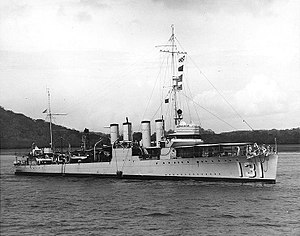USS Buchanan (DD-131)
 USS Buchanan off Balboa, Panama, 18 May 1936
| |
| History | |
|---|---|
| Name | USS Buchanan |
| Namesake | Franklin Buchanan |
| Builder | Bath Iron Works |
| Laid down | 29 June 1918 |
| Launched | 2 January 1919 |
| Commissioned | 20 January 1919 |
| Decommissioned | 7 June 1922 |
| Recommissioned | 10 April 1930 |
| Decommissioned | 9 April 1937 |
| Recommissioned | 30 September 1939 |
| Decommissioned | 9 September 1940 |
| Stricken | 8 January 1941 |
| Identification | DD-131 |
| Fate | Transferred to United Kingdom 9 September 1940 |
| Name | HMS Campbeltown |
| Commissioned | 9 September 1940 |
| Identification | Pennant number I42 |
| Fate | Expended as demolition ship during St. Nazaire Raid . Destroyed 29 March 1942. |
| General characteristics | |
| Class and type | Wickes-class destroyer |
| Displacement | 1,260 tons |
| Length | 314 ft 4 in (95.8 m) |
| Beam | 30 ft 6 in (9.3 m) |
| Draft |
|
| Propulsion |
|
| Speed | 35 knots (65 km/h) |
| Complement | 158 officers and enlisted |
| Armament |
|
USS Buchanan (DD-131), named for Franklin Buchanan, was a Wickes-class destroyer in the United States Navy.
Buchanan was transferred to the
The first USS Buchanan (DD-131) was
Again placed in full commission in December 1934, she resumed operations with Division 5, Destroyers, Battle Force. Buchanan was again out of commission at San Diego from 9 April 1937 until 30 September 1939 at which time she was refitted for action with Division 65, Destroyer Squadron 32,
Upon her arrival at
Saint-Nazaire Raid

In 1942, the German battleship Tirpitz anchored at Trondheim in Norway was considered to present a grave threat to Atlantic convoys. However, should the ship enter the Atlantic then the dry dock originally built for the ocean liner SS Normandie in the German-occupied port of Saint-Nazaire, France, was the only one in German hands on the Atlantic seaboard large enough to hold her.[1] It was considered that if this dock could be put out of action, then a sortie by Tirpitz into the Atlantic would be much more dangerous for her, and probably not worth the risk.[2] The obsolete Campbeltown was selected for the task, and cosmetic modifications quickly done to make her look similar to a German Möwe-class torpedo boat.
Using genuine German recognition signals, the force approached to within less than a mile of the harbour before they were fired upon, Campbeltown as the largest target drawing most of the fire. At 01:34 on 28 March 1942, Campbeltown rammed the dock gate four minutes later than planned. Troops and crew came ashore under heavy German fire and set about demolishing the dock machinery. 169 of the raiders were killed (64 commandos and 105 sailors) out of the 611 men in the attacking force. Of the survivors, 215 were captured and 222 were evacuated by the surviving small craft. A further five evaded capture and travelled overland through France to Spain and then to Gibraltar.[3]
The charges in Campbeltown exploded the next day, 28 March, an hour and a half after the latest time that the British had expected them to detonate. Although the ship had been searched by the Germans, the explosives had not been detected. The explosion killed around 250 German soldiers and French civilians and demolished both the front half of the ship and the 160-ton caisson, the inrush of water into the dock washing the remains of the ship into it. The dock was rendered unusable for the rest of the war, and was not repaired until 1948.[4][5]
Ship's bell
The bell was given to Campbelltown, Pennsylvania as a gesture of appreciation towards the United States for the Lend-Lease programme. It was lent by the town to the current HMS Campbeltown, a Type 22 frigate, when it was commissioned in 1989, and remained on the ship whilst it was in service with the Royal Navy.[6] The bell was returned to the town on 21 June 2011 when HMS Campbeltown was decommissioned.
Films
The 1952 film Gift Horse and the 1968 film Attack on the Iron Coast were both loosely based on the story of HMS Campbeltown.
Footnotes
- ^ "The Chariot Story". St Nazaire Society. Archived from the original on 11 September 2012. Retrieved 24 March 2007.
- ISBN 0-14-008614-5.
- ^ "HMS Campbeltown Commemorates the Raid on St Nazaire 28 March 1942". UK Ministry of Defence. Archived from the original on 9 January 2007. Retrieved 24 March 2007.
- ^ "St Nazaire, 80th anniversary of the 'Greatest Raid'". CWGC. Retrieved 27 March 2023.
- ^ Groh, Joshua (26 March 2021). "Eight decades after the HMS Campbeltown exploded in a strategic World War II raid, its bell resides peacefully in Campbelltown". LebTown. Retrieved 27 March 2023.
- ^ "HMS Campbeltown". UK Ministry of Defence. Archived from the original on 8 January 2007. Retrieved 26 March 2007.
References
 This article incorporates text from the public domain Dictionary of American Naval Fighting Ships. The entry can be found here.
This article incorporates text from the public domain Dictionary of American Naval Fighting Ships. The entry can be found here.- "HMS Campbeltown Commemorates the Raid on St Nazaire 28 March 1942". UK Ministry of Defence. Archived from the original on 9 January 2007. Retrieved 25 March 2007.
- ""The Greatest Raid of All" and other Wartime Memories of the Royal Navy". WW2 People's War (BBC). Retrieved 25 March 2007.
